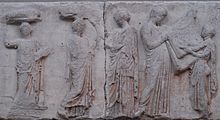The High Priestess of Athena Polias held the highest religious office in Ancient Athens.

The priesthood was a hereditary position open only to married women, with a lifetime appointment.[1] The officeholder enjoyed great prestige, and played a role in affairs of state which was otherwise closed to women in Ancient Athens; there are several recorded instances of a High Priestess influencing a historically-significant event or recommending a specific person for public office.
The High Priestess supervised the city cult of Athena, enshrined in the Parthenon, and was the chief of the lesser officials such as the plyntrides, arrephoroi and kanephoroi.[2] Athena Polias ("Athena of the City") was one of the three divine patrons of the Acropolis of Athens, the other two being served by the High Priest of Poseidon-Erechtheus and the Priestess of Athena Nike.
The best-attested High Priestess was Lysimache I, who held the office for 64 years during the early 4th century BCE[3] and who may have inspired the character of Lysistrata in Aristophanes's play.[4]
If the office was still active during the late fourth century, it would have been suppressed during the Theodosian persecutions, along with all other non-Christian forms of religious expression.
See also
editReferences
edit- ^ O'Brian, Julia (2014). The Oxford Encyclopedia of the Bible and Gender Studies. New York: Oxford. p. 174. ISBN 9780199836994. Retrieved 12 November 2023.
- ^ Joan Breton Connelly, Portrait of a Priestess: Women and Ritual in Ancient Greece
- ^ Lefkowitz, Mary; Fant, Maureen (2016). Women's life in Greece and Rome : a source book in translation. Baltimore: Johns Hopkins University Press. p. 364. ISBN 0801883105.
- ^ Cohen, Edward (2000). The Athenian nation. Princeton NJ: Princeton University Press. p. 46-47. ISBN 9780691094908.
- Jeffrey M. Hurwit, The Athenian Acropolis: History, Mythology, and Archaeology
- Joan Breton Connelly, Portrait of a Priestess: Women and Ritual in Ancient Greece
- Garland, Robert, Religion and the Greeks, Bristol Classical Press, London, 1994
You can help expand this article with text translated from the corresponding article in Swedish. (December 2019) Click [show] for important translation instructions.
|